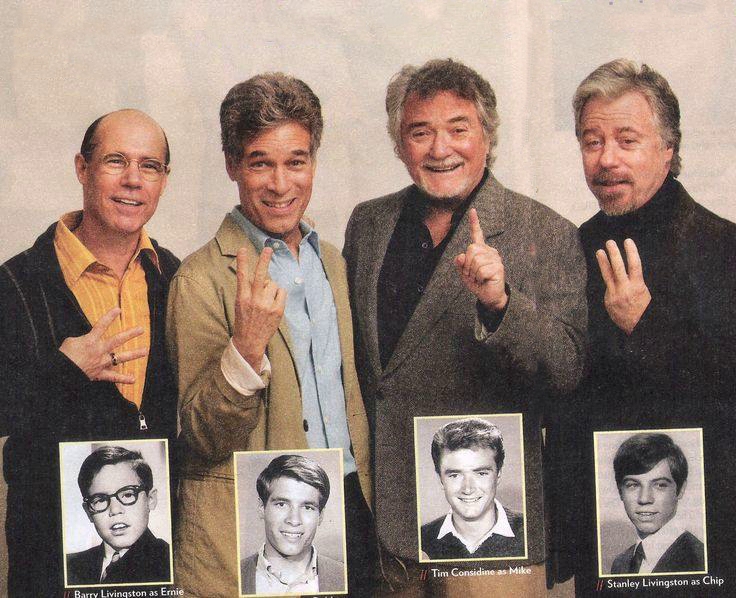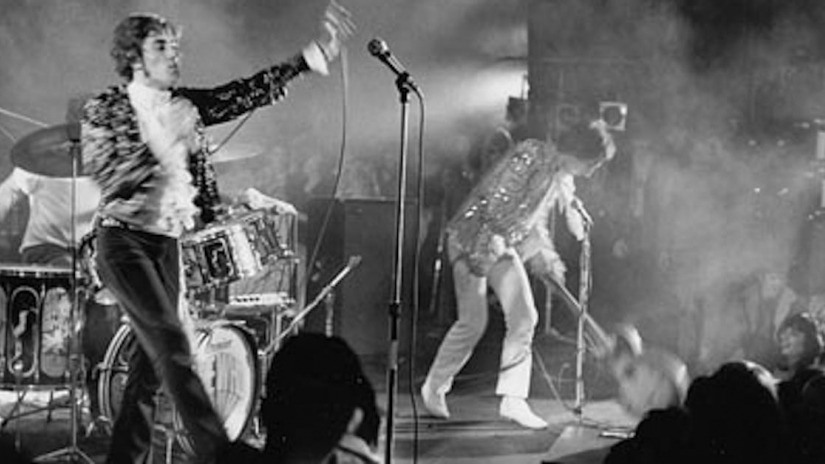The Toes Knows
 When It Comes to Diagnosing Health Problems – Look to Your Feet
When It Comes to Diagnosing Health Problems – Look to Your Feet
You might not think about them (unless you stub one of them), but your toes can sometimes provide early clues about your health.
- For example, if you have numbness, tingling or burning in your toes, that can be an early indicator of diabetes.
- Or cold or blue toes often results from poor circulation and that can be an indicator of heart disease.
Should you start noticing any abnormalities in you toes or toenails, make sure your contact your health professional as soon as possible
Wait - If It's "My Three Sons," How Come They're Are 4 of You?
And why does the adopted son look so much like the 3rd birth son?

Avoid Summer Home Repair Scams
 Warm weather brings out all kinds of pests. One you need to watch out for is the traveling “home repair” scam artist.
Warm weather brings out all kinds of pests. One you need to watch out for is the traveling “home repair” scam artist.
Typically, they’ll knock on your door and claim that they just happen to be working in your area (sound familiar?). The most popular scam is an offer to “repave” or “reseal” your driveway (or maybe, clean & fix your gutters). Usually, they’ll also offer to “give you a deal” because, like we mentioned, they just happen to be doing another job in your neighborhood.
One of three things will probably happen. They will do the job using substandard material. Or they’ll only do part of the work and disappear. Or they won’t do any of the work and will disappear with your down payment.
Always do your own hiring for home repairs. Make sure you hire someone who is properly licensed for your state or municipality. If they’re also insured, so much the better.
Be on the lookout. The Better Business Bureau says the most common target for these fraudsters are older Americans. You know, people like us!
Protecting Yourself from Falls
As we age, falls can become something more serious than they were during our Wonder Years. Experts say we can take tips from Hollywood’s stuntmen and women.
If you feel yourself falling (and I’m speaking as someone who has fallen off a ladder more than once), here’s some things you can do to minimize the damage.
 If you’re falling backwards:
If you’re falling backwards:
- Tuck your chin to your chest
- Bend your knees, if possible, & try to land on your butt
- Curve your back and try rolling onto your shoulder
- Keep your arms close by your sides
If you’re falling sideways:
- Bend your knees
- Tuck your chin
- Keep your head lifted
- Allow yourself to go limp
- If possible, roll onto your bottom thigh, then roll onto your upper back
- Try not to fall onto your hip
- Do not stick your arms out to brace your fall

If you’re falling forwards:
- Bend your knees
- Tuck your chin to your chest
- Keep your head tilted away from the ground
- Try and roll on the outside of your thigh
- Keep that momentum going as you roll to your side and then your back
- Do not stick your arms out to brace your fall
Overall, the number one rule is to relax your body as much as possible. Also, don’t try and pop right back up after a fall. We know your ego maybe bruised as well as your body, but the experts say to stay there on the ground and take a few minutes to assess whether you’re hurting any place before attempting to return to an upright position.
The Essential Boomer Album Collection Part 12 – Who’s Next
 The Who’s Tommy LP had been a blessing and a curse. It was a blessing in that it finally established the Who as a headline rock act in the United States and most of the rest of the world. But it was curse in that Pete Townsend didn’t know what he could do to top it.
The Who’s Tommy LP had been a blessing and a curse. It was a blessing in that it finally established the Who as a headline rock act in the United States and most of the rest of the world. But it was curse in that Pete Townsend didn’t know what he could do to top it.
The band stalled. Instead of a studio album, they released a live set, The Who Live at Leeds. That actually proved to be a shrewd move. The band sounded way better live than they did in the studio at the time Tommy came out. Bands also make way more money on their live gigs than do on their records. So, Live at Leeds cemented their well-deserved reputation as one of the very best live acts in rock, but Townsend was still stuck. How was he going to top Tommy with a studio album?
Pete came up with a new concept he called Lifehouse. In brief, Townsend envisioned a storyline that took place in the near future when people live indoors because of pollution and only experienced things that are fed to them inside all-encompassing suits. In a way, Pete had correctly foreseen the rise of social media and virtual reality, which has cut down on face-to-face human interaction significantly. What Lifehouse would actually be – an album, a film, a stage musical – kept shifting. But he began to write songs for the project.
 One of his main ideas for the project revolved around the musicians and audience fusing together to create something musicians couldn’t create by themselves. Excited, Townsend booked the Who into the Young Vic Theater in London and began playing these new songs for audiences. However, he never got the feedback from the crowd he was looking for, so the Who flew across the pond to New York City and began trying to work out the album at the Record Plant. However, Kit Lambert, one of the band’s managers who had accompanied them to the States had gotten involved with heroin and Townsend feared Keith Moon might soon head down that path if they stayed in New York.
One of his main ideas for the project revolved around the musicians and audience fusing together to create something musicians couldn’t create by themselves. Excited, Townsend booked the Who into the Young Vic Theater in London and began playing these new songs for audiences. However, he never got the feedback from the crowd he was looking for, so the Who flew across the pond to New York City and began trying to work out the album at the Record Plant. However, Kit Lambert, one of the band’s managers who had accompanied them to the States had gotten involved with heroin and Townsend feared Keith Moon might soon head down that path if they stayed in New York.
So, back they flew to London and holed up at Olympic Studios. As the rest of the band had cooled considerably on the Lifehouse idea, engineer/co-producer Glyn Johns convinced the group to jettison the idea of a concept album, but just develop the songs that Pete had written for the project. You know, just focus on releasing a really good studio album.
And that’s just what they did.
First of all, they were impressed with Johns at the control board. He was able to get the band to sound in-studio pretty much the way they sounded live. Next, Townsend began incorporating synthesizer into his songs in a way no rock band had before – using it not just to add loopy little flourishes, but as one of the main instruments in the mix. He also found ways to infuse the synth parts with rock rhythms, again, something nobody had done before.
As there was no longer any need to adhere to an overall concept, the boys asked John Entwistle if he had a song he’d like to contribute. The Ox had one left over from a solo project he’d been working on, a little ditty that had been inspired (and exaggerated according to Entwistle) by a fight he’d had with "My Wife."
 The album, now called Who’s Next, was released in August of 1971. It was an immediate commercial and critical success. It went to #1 in the UK and #4 in States (surprisingly, the Who have never had a #1 LP in America). It’s widely thought to be the band’s best LP with many of its tracks “Baba O’Riley,” “Won’t Get Fooled Again, “Behind Blue Eyes,” “Going Mobile,” and others, becoming staples of rock radio and in-concert favorites. It has been re-released multiple times, often with additional tracks from those sessions added as a bonus.
The album, now called Who’s Next, was released in August of 1971. It was an immediate commercial and critical success. It went to #1 in the UK and #4 in States (surprisingly, the Who have never had a #1 LP in America). It’s widely thought to be the band’s best LP with many of its tracks “Baba O’Riley,” “Won’t Get Fooled Again, “Behind Blue Eyes,” “Going Mobile,” and others, becoming staples of rock radio and in-concert favorites. It has been re-released multiple times, often with additional tracks from those sessions added as a bonus.
That cheeky cover shot? Yeah, only Townsend really took a leak against he monolith. The other three members of the band had their “marks” created with a little hot water.
BTW - Who’s Next also consistently shows up on lists of the greatest rock albums ever from sources like Rolling Stone, Village Voice and others.
"American Graffiti" Turns 50
 When it debuted in theaters 50 years ago this summer, American Graffiti touched off a tidal wave of 1950s nostalgia (even though the film was set in 1962) that engulfed the 1970s, giving us Happy Days, Sha Na Na and Grease! It also launched the careers of several actors including Richard Dreyfuss and Cindy Williams. It allowed Ron Howard to graduate from child star to adult actor (and eventually award-winning director), And of course, it gave writer/direct George Lucas enough clout in Hollywood to finally get his pet project bankrolled, a little thing he called Star Wars. Maybe you’ve heard of it?
When it debuted in theaters 50 years ago this summer, American Graffiti touched off a tidal wave of 1950s nostalgia (even though the film was set in 1962) that engulfed the 1970s, giving us Happy Days, Sha Na Na and Grease! It also launched the careers of several actors including Richard Dreyfuss and Cindy Williams. It allowed Ron Howard to graduate from child star to adult actor (and eventually award-winning director), And of course, it gave writer/direct George Lucas enough clout in Hollywood to finally get his pet project bankrolled, a little thing he called Star Wars. Maybe you’ve heard of it?
Here’s a few things you might not know about this landmark film:
1. George Lucas made the film to prove a point to his then-wife. His first film THX1138 had flopped, both commercially and critically. His friend, Francis Ford Coppola told him, “Don’t be so weird.” His wife at that time, Marcia urged him to make a film that involved the audience emotionally. He told her there was nothing easier than involving the audience emotionally and wrote the script of American Graffiti to prove it.
 2. The movie was almost called A Slow Night in Modesto. Universal Studios didn’t understand the title (join the club) and wanted it changed. They submitted several alternatives, really pushing A Slow Night in Modesto. But Lucas stuck to his guns.
2. The movie was almost called A Slow Night in Modesto. Universal Studios didn’t understand the title (join the club) and wanted it changed. They submitted several alternatives, really pushing A Slow Night in Modesto. But Lucas stuck to his guns.
3. Universal wanted to release the film as a made-for-TV movie. Universal had so little faith in American Graffiti’s subject matter that they wanted it released directly to television. However, the film’s producer – the aforementioned Francis Ford Coppola, had just won a raft of Oscars for his breakthrough movie, The Godfather, and used his newfound clout to put the film into theaters.
 4. Harrison Ford refused to cut his hair for the small part he played. At the time of filming, Harrison Ford had just about given up on his dream of an acting career. He was working mainly as a carpenter when Lucas offered him the minor role of Bob Falfa (the out-of-town racer who spends the film looking for Paul Le Mat’s John Milner). The script called for Falfa to have a flattop haircut, but as the part was so small, Ford would only do it if he didn’t have to cut his hair. Lucas agreed, instead putting Ford in a cowboy hat to hide his more modem hairstyle.
4. Harrison Ford refused to cut his hair for the small part he played. At the time of filming, Harrison Ford had just about given up on his dream of an acting career. He was working mainly as a carpenter when Lucas offered him the minor role of Bob Falfa (the out-of-town racer who spends the film looking for Paul Le Mat’s John Milner). The script called for Falfa to have a flattop haircut, but as the part was so small, Ford would only do it if he didn’t have to cut his hair. Lucas agreed, instead putting Ford in a cowboy hat to hide his more modem hairstyle.
5. One of the writers had to become Mackenzie Phillips’ legal guardian. Mackenzie Phillips was actually one of the actors really playing her own age. Just 12 at the time of the production, she almost lost out on the part because of a California law that required a parent or legal guardian to be present on the set whenever she was filming. They satisfied the law when one of the movie’s producers, Gary Kurtz, stepped up and actually became her legal guardian while American Graffiti was in production. She lived with Kurtz & his wife during the filming and reported it was a very happy arrangement.
When it was released, American Graffiti seemed like it was showing a bygone era, but the film was set just 11 years in the past. Imagine if a film was released today taking “a nostalgic look” at 2012. Think it would be a big hit?

Great Moments in Boomer Advertising
Our question of the week: Are you scrubbed?

How Can I Tell If I’ve Got Long COVID?
 Most of us have heard or read about it. Some of us may even have a friend or family member suffering from it. But how can you tell if you have the long form of COVId-19?
Most of us have heard or read about it. Some of us may even have a friend or family member suffering from it. But how can you tell if you have the long form of COVId-19?
Experts say long COVID means your symptoms (fatigue, chest pain, cough, brain fog, etc.) last longer then 4 weeks. There is no specific test for long COVID yet. What’s more, there is no specific treatment for it either. The good news is that only a minority of COVID patients develop the long form of the disease. The less severe your initial symptoms, the less likely you are to have long COVID. Also, most cases do recover their full health within 3 months. Rest and paring back on your daily activities can help you recover more quickly.
As always, consult your physician should you feel you have long COVID. And we wish you a speedy recovery!
One Voice Good. 2 (3 or 4) Voices Better.
 It’s been with rock since the beginning – the idea of one outstanding singer with a backing band. Think of Buddy Holly & the Crickets, Mick Jagger & the Rolling Stones, Bruce Springsteen & the E Street Band, Freddie Mercury & Queen and so many more.
It’s been with rock since the beginning – the idea of one outstanding singer with a backing band. Think of Buddy Holly & the Crickets, Mick Jagger & the Rolling Stones, Bruce Springsteen & the E Street Band, Freddie Mercury & Queen and so many more.
But there’s second dynamic some bands follow – one that we think produces much more interesting results. That’s the concept of sharing lead vocal duties. The two bands who led this trend are also the two groups that definitely moved us from the “fifties sound” into the “Sound of the Sixties”: The Beach Boys & the Beatles.
Both group’s albums featured every member of those combos taking a stab at lead vocals. While John & Paul split the majority of Beatles lead vocal duties, George was typically allowed two songs of his own while Ringo would take a stab at least one vocal per LP. Meanwhile, the Beach Boys’ Mike Love is often thought of as a lead singer, but that’s just because he didn’t play any actual instrument on stage. The truth is that Carl Wilson, Al Jardine, Brian Wilson & Dennis Wilson all took turns singing lead on the band’s songs.
 Having more than one vocalist allows a band to sound somewhat different from tune to tune. Here is a short list (by no means complete) of some of the band’s who pass the microphone around:
Having more than one vocalist allows a band to sound somewhat different from tune to tune. Here is a short list (by no means complete) of some of the band’s who pass the microphone around:
- ABBA
- Beach Boys
- Beatles
- Bee Gees
- Buffalo Springfield
- Byrds
- Crosby, Stills, Nash &Young
- Eagles
- Fleetwood Mac
- Mamas & Papas
- Monkees
- Moody Blues
- Mothers of Invention
- Pink Floyd
- 10cc
- Three Dog Night

Then, there are a handful of bands who aren’t quite as generous as the above-named groups, but not as stingy as the solo frontman bands. These bands typically feature two vocalists who trade leads and they include:
- Cars
- Cream
- Doobie Brothers
- Hall & Oates
- Heart
- Jefferson Airplane
 And finally, we have the Who. Totally unique in this grouping. For the most part, Roger Daltrey has functioned as the band’s lead singer, but often, there are bits within a Who song where the vocals are handled by Pete Townsend (and a handful where Pete sings lead throughout the song). Typically, bassist John Entwistle contributed a song or two to each LP and sang lead on those and once in a blue moon (pun intended), Keith Moon would get a shot at singing lead. But, unquestionably, when you think of the Who, you picture Daltrey handling the vocals.
And finally, we have the Who. Totally unique in this grouping. For the most part, Roger Daltrey has functioned as the band’s lead singer, but often, there are bits within a Who song where the vocals are handled by Pete Townsend (and a handful where Pete sings lead throughout the song). Typically, bassist John Entwistle contributed a song or two to each LP and sang lead on those and once in a blue moon (pun intended), Keith Moon would get a shot at singing lead. But, unquestionably, when you think of the Who, you picture Daltrey handling the vocals.
So, in the final analysis, which style do you prefer and can you think of any multi-vocalist bands we’ve missed?
Tips For Shopping on Social Media
![]() As social media platforms like Facebook and Instagram have developed, they have, of course, become a fertile ground for advertisers – and for scam artists. If you find something tempting popping up in your social media feed, don’t click and order until you’ve taken a few precautionary steps.
As social media platforms like Facebook and Instagram have developed, they have, of course, become a fertile ground for advertisers – and for scam artists. If you find something tempting popping up in your social media feed, don’t click and order until you’ve taken a few precautionary steps.
Look for an actual physical address or phone number. Nearly 43% of social media scams involve online shopping. Complaints range from wrong items, items that were not as pictured or items not even arriving head up the list. So, see if you can actually verify the existence of the company that’s trying to sell you something.
See if you can locate the business online through a search engine and not just by clicking on the ad.
Check Google or other online reviews. And don’t rely on a website specifically set up for the retailer.
Search for bad reviews or complaints by Googling the name of the product, plus the words “scam” or “complaint.”
See if you can find the same item or something similar from an online retailer you trust.
Finally, never pay with gift cards, cryptocurrency, or wire transfers. Always use a credit card or online payment service such as PayPal. That way, if you get scammed or you’re not happy with your purchase, you can contact your credit card company and have your payment refunded.
Pop Up Player
Latest Posts–Movies & TV
-
The BOO Tube
Local TV Horror Hosts – most of us had ‘em. In New York and northern Jersey, it was Zacherley (aka John Zacherle). In L.A., it was Vampira. Milwaukee had Dr. Cadaverino and Tampa had Dr.…
-
Halloween Movie Ideas - Take 2
GORGON (1964) We were born too late to experience the great Universal horror films in first run theaters. Instead, we watched them on our local TV station’s “Shock-Horror-Monster-Chiller-Nightmare Theater.” You remember. Those late night weekend…
-
Halloween Movie Ideas
I WALKED WITH A ZOMBIE I Walked with a Zombie may be the best movie with the dumbest title in motion picture history. Cranked out by the b-movie horror unit at RKO pictures in 1943,…
-
Now Playing at the Boomtown Drive-In: "I Married a Monster from Outer Space"
Just like I Walked with a Zombie, behind the incredibly silly title lurks a pretty decent little B-movie. I Married a Monster from Outer Space was made by Paramount Pictures in 1958. Directed by Gene…
-
The TV That Time Forgot: Hazel (1961-66)
Hazel was a very popular sit-com that ran for 5 seasons (4 in full color), producing 154 shows, that was also quite popular in syndication. The show was based on a popular one panel cartoon…
-
The TV That Time Forgot: Annie Oakley
There was a time when Westerns dominated television programming so thoroughly that it was tough (with no home video, no streaming, and just 3 networks if you lived in a city big enough to have…


